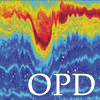
|
Harper Simmons Senior Principal Oceanographer hsimmons@apl.washington.edu Phone 907-978-2750 |
Education
B.A. Physics, University of Alaska, 1995
M.S. Coastal Hydrology, University of Alaska, 1996
Ph.D. Physical Oceanography, Florida State University, 2000
|
Publications |
2000-present and while at APL-UW |
Near-bottom baroclinic and submesoscale instabilities at the Chukchi Shelf Break Couto, N., J.A. MacKinnon, H.L. Simmons, and M.H. Alford, "Near-bottom baroclinic and submesoscale instabilities at the Chukchi Shelf Break," J. Phys. Oceanogr., 55, 2197-2208, doi:10.1175/JPO-D-24-0161.1, 2025. |
More Info |
1 Nov 2025 |
|||||||
|
We present novel observations of submesoscale instability along a sloping bottom in the Arctic Ocean where the Chukchi Sea meets the Beaufort Sea. Highly spatially resolved cross-shelf sections of hydrography and velocity suggest that baroclinic instability may have been active in the bottom boundary layer, generating 2–4-km-scale boluses. A downslope Ekman transport may have contributed to weakening stratification in the bottom layer and created the flow conditions for instability to occur. Additionally, potential vorticity analyses revealed that the flow was susceptible to symmetric and gravitational instability. Regions of the flow susceptible to symmetric instability were coincident with the most coherent eddy features we measured. Regions favorable to gravitational instability were observed within less coherent eddy features and at separation scales similar to the eddy widths and were associated with elevated turbulence (ε = 1 x 10-8–1 x 10-7 W kg-1), weak stratification, and an anomalously strong baroclinic component of potential vorticity, typically associated with symmetric instability. The observed plumes of gravitational instability are consistent with localized density inversions that could arise from shear-driven processes like Kelvin–Helmholtz instability or secondary instabilities associated with sharp frontal gradients at eddy edges. This collection of instability processes may play an important role in water mass modification and evolution at this crucial gateway to the Arctic Ocean and along sloping shelves subject to downslope Ekman transport in other parts of the World Ocean. |
|||||||||
Passive acoustic estimates of sound speed from vertical line array data in the Nordic Seas Taylor, R.T., M.S. Ballard, J.D. Sagers, L. Johnson, and H. Simmons, "Passive acoustic estimates of sound speed from vertical line array data in the Nordic Seas," JASA Express Lett., 5, doi:10.1121/10.0037103, ,2025. |
More Info |
16 Jul 2025 |
|||||||
|
In wind-wave driven ambient sound environments, the cross-correlation of acoustic data recorded on vertically separated hydrophones can provide estimates of the average sound speed between hydrophones. Deployment of a 52-element vertical line array of hydrophones located on a 425 m deep ridge in the Nordic waters near Jan Mayen Island enabled estimates of the water column sound speed profile. Sound speed profiles were estimated for each 24-min recording, which were collected every four hours over the course of the year-long experiment, supplying a wide range of environmental conditions. Over the full experiment, estimated sound speeds had a root-median-square error of 0.79 m/s when compared to direct measurements. |
|||||||||
Near-inertial energy variability in a strong mesoscale eddy field in the Iceland Basin Voet, G., and 13 others including H.L. Simmons, C.B. Whalen, R.-C. Lien, and J.B. Girton, "Near-inertial energy variability in a strong mesoscale eddy field in the Iceland Basin," Oceanography, 37, 34-47, doi:10.5670/oceanog.2024.302, 2024. |
More Info |
1 Dec 2024 |
|||||||
|
An 18-month deployment of moored sensors in Iceland Basin allows characterization of near-inertial (frequencies near the Coriolis frequency f with periods of ~14 h) internal gravity wave generation and propagation in a region with an active mesoscale eddy field and strong seasonal wind and heat forcing. The seasonal cycle in surface forcing deepens the mixed layer in winter and controls excitation of near-​inertial energy. The mesoscale eddy field modulates near-inertial wave temporal, horizontal, and vertical scales, as well as propagation out of the surface layer into the deep permanent pycnocline. Wind-forced near-inertial energy has the most active downward propagation within anticyclonic eddies. As oceanic surface and bottom boundaries act to naturally confine the propagation of internal waves, the vertical distribution of these waves can be decomposed into a set of "standing" vertical modes that each propagate horizontally at different speeds. The lowest modes, which propagate quickly away from their generation sites, are most enhanced when the mixed layer is deep and are generally directed southward. |
|||||||||






